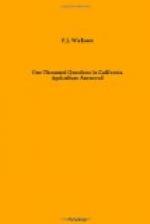I want information about flax as a crop. I have been having some land graded for alfalfa and I have had to wait so long I am now doubting the advisability of seeding it all under these conditions until fall, as hot weather will soon come. I want some good crop to plant in the checks and give two good irrigations. What would you think about rye for straw for horse collars? I do not wish to consider corn, as the stalks would be troublesome. Potatoes would necessitate disarranging the land too much and would require more attention than I am in shape to give just flow. Everybody grows wheat, barley and oats. I want something that I can get a special market for.
To succeed with flax, the seed ought to be sown in the fall, or early winter, in California, and the plant will make satisfactory growth under about the same conditions that suit barley or wheat. Spring sowing would not give you anything worth while except on moist bottom land. Rye is also a winter-growing grain. To grow rye straw for horse collars would be unprofitable unless you could find some local saddler who could use a little, and it is probable you could not get a summer growth of rye which would give good straw, even if you had a market for it. You could get a growth of stock beets, field squashes, or pumpkins for stock feeding. In fact, the latter would give you most satisfaction if you have stock to which they can be fed to advantage. Sorghum is our chief dry-season crop, but that makes stalks like corn and would, therefore, be open to the same objections. Has it never occurred to you that people grow the common crops, not because they are stupid, but because those are the things for which there is a constant demand and the best chance for profitable sale? Efforts to supply special markets are worth thinking of, but seldom worth making unless you know just who is going to buy the product and at what price.
California Insect Powder.
What part of the plant is used in making insect powder and how is it prepared? Is the plant a perennial? What soil suits it best?
The plant is Pyrethrum cinerariaefolium and has a white blossom resembling the common marguerite. The powder is made of the petals and the seed capsules or heads are thoroughly dried in the sun and ground with a run of stone such as was formerly used for making flour. The powder must be finely ground, and only good powder can be made in a mill suitably equipped for that purpose. The plant is a perennial, beginning to bloom the second year from seed. It will grow in any good soil with ordinary cultivation. Twenty-five years ago it was thought that a great California industry might be established on that basis, but there is at the present time but one establishment, which grows about all the material it can use on its own ranch in Merced county, on a fine, deep loam which the plant seems to enjoy.
Rotations for California.
I wish to work out a practical system of crop rotation suitable to the climate and conditions obtaining in southern California. Would you recommend different systems for grain lands and irrigated lands?




